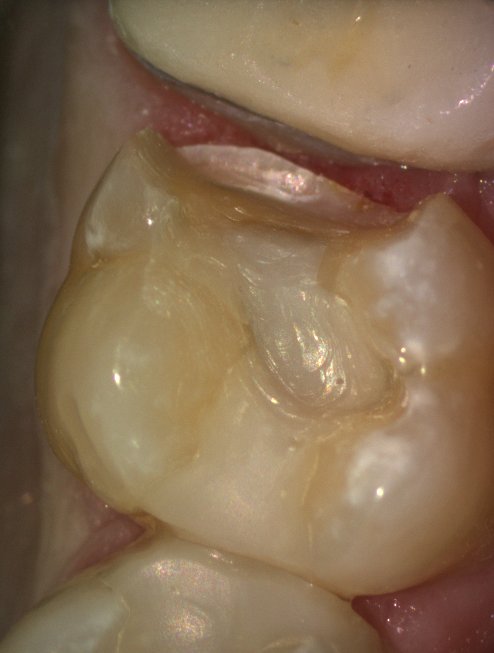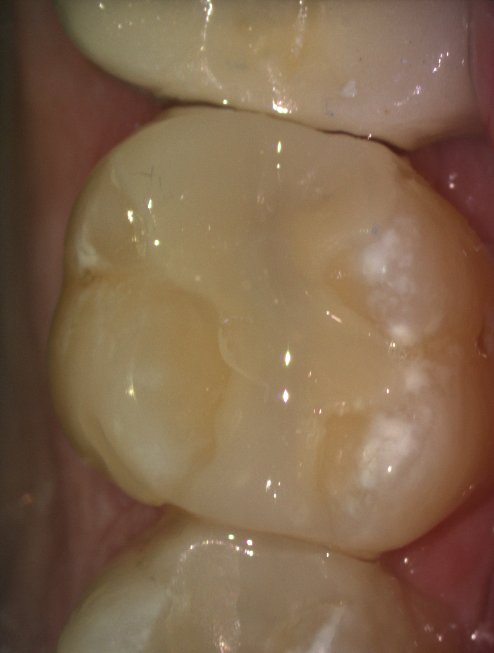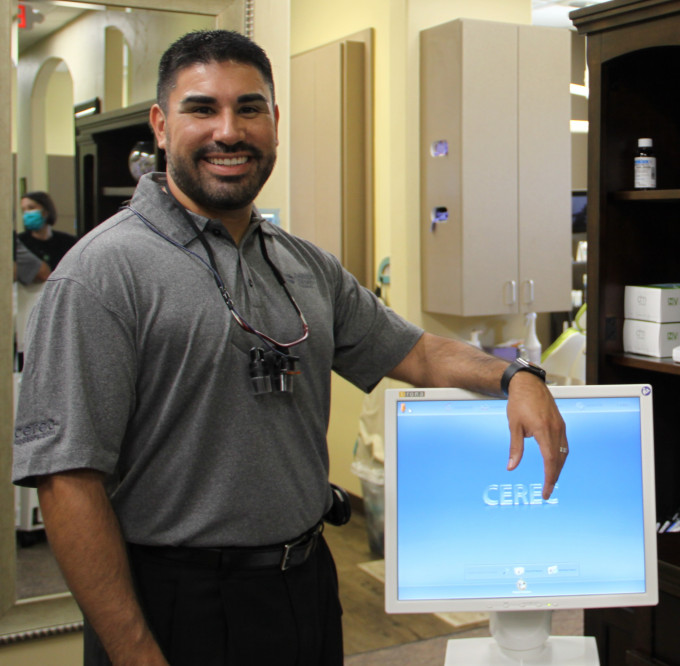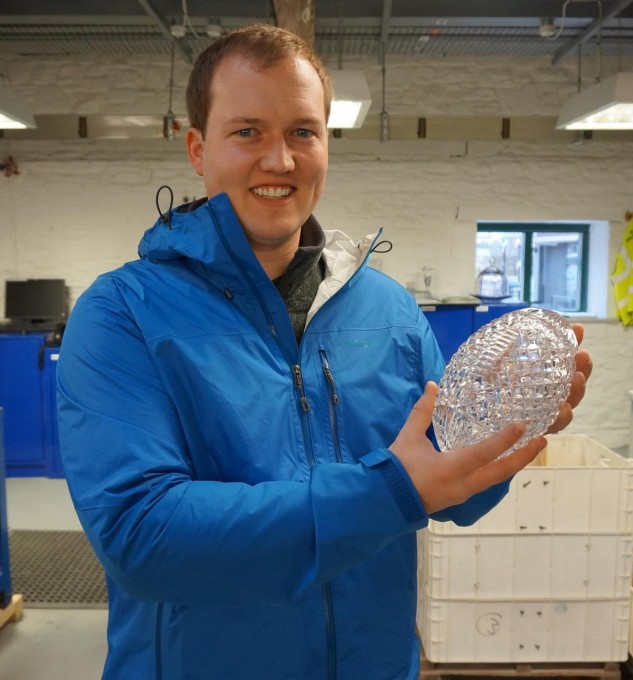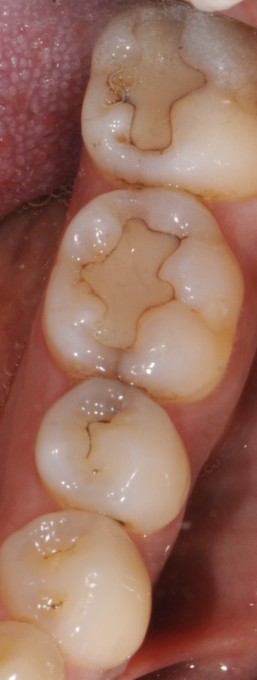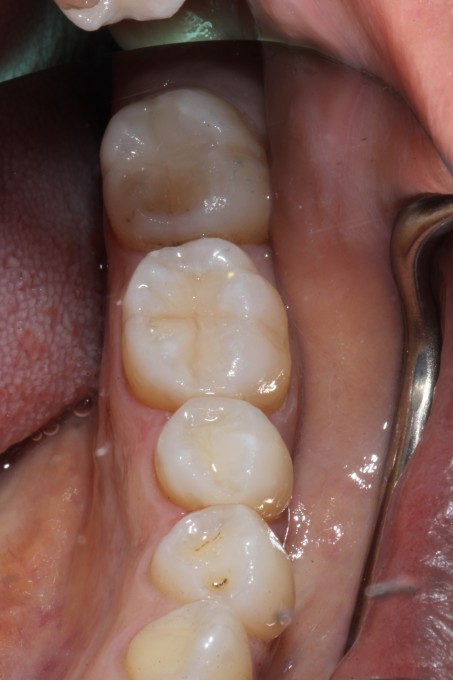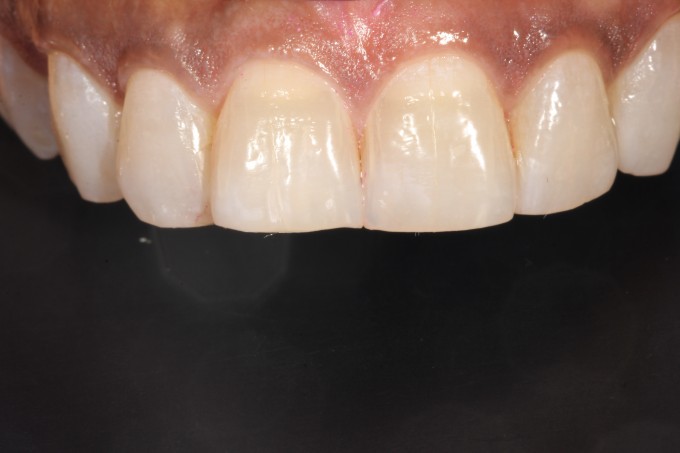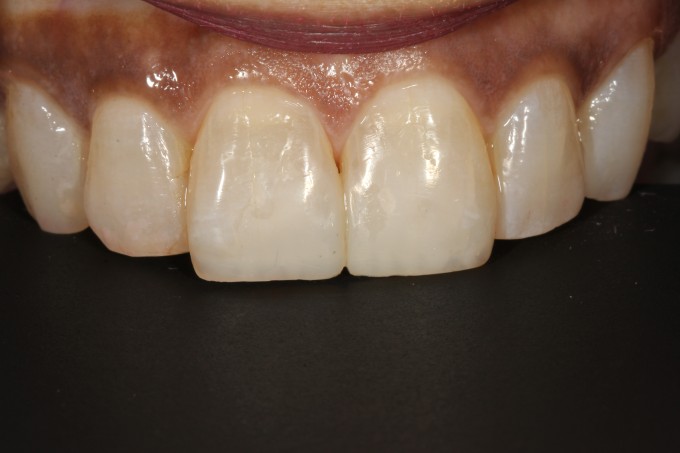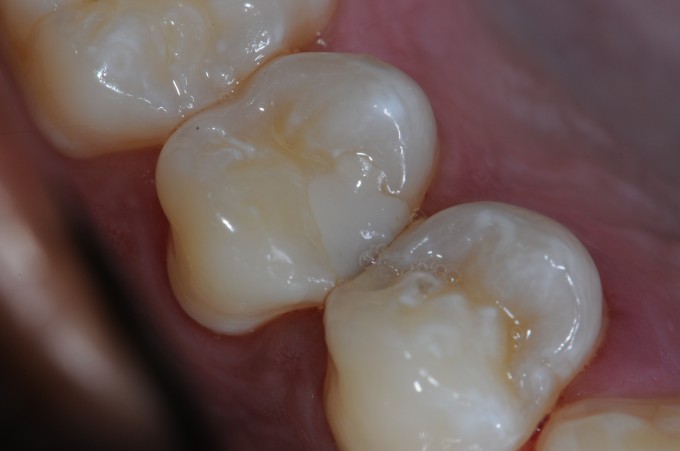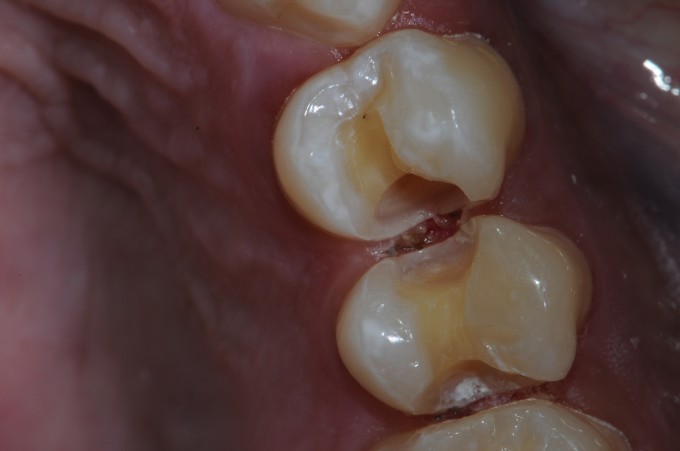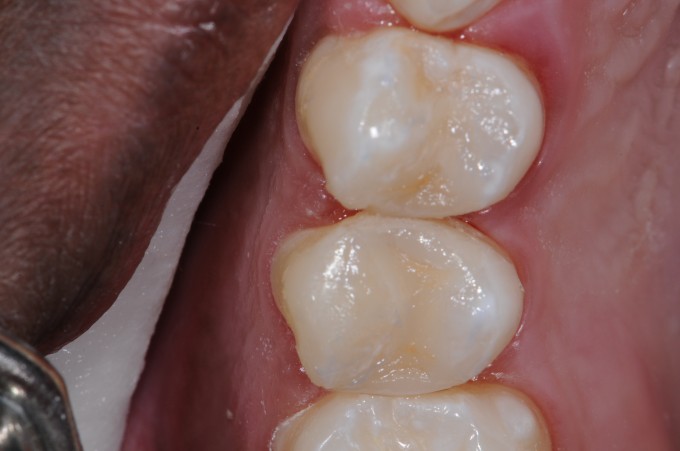To Mill or Not To Mill... Everyday Fillings
When is it worth it to mill out fillings vs doing them direct? Honestly, I would be happy to mill out every filling. To not have to place another matrix band or push a wedge into unsuspecting gums and watch patients flinch (because I am sooooo strong)... it sounds amazing. It's not my reality however for several reasons: a) sometimes I can be more conservative placing a direct filling and b) cost plays a factor. One block that costs around $30 averages 4.6 comps of 3M Ultra Filtek composite. If I can mill out 2 restorations out of one block obviously that is half of that. I don't often do fillings that are that big, but there are times that it really does pay off do mill out an indirect composite- even if I still bill it as a composite filling at PPO fees. Here is one them:
Here is a prep that has a large buccal/lingual width and the distal half of the tooth has a heart shape that doesn't adapt well to matrix bands. He had that frustrating decalcifcation ring that that kept making my proximal box larger and larger.
Make sure the walls converge. This design takes minutes. It's so fast!
Bonding this in has amazing contacts that are controlled instead of leaving an open contact or point contact that wedges in food.
This was just one of those cases that was successful because I milled it and I am so happy that I own a CEREC. I used a 3M z100 block and billed it as a composite. I had total control over the contacts and the margins (not that I am a control freak or anything). There are no voids in the large fill... I easily could have used Cerasmart, Enamic or Lava Ultimate too.
Do you mill out your filings? Why or why not???
I find that unless I am replacing a moderately large restoration, or definitely replacing a cusp, inlays are just not that efficient for me in terms of both cost of materials and cost of time. The vast majority of class 2 restorations I place are minimal slot type preps.
I would say for my Class II restorations- I am 98% of the time using CEREC. Even if it takes me a little longer with Cerec the first time, I am confident I will not have to redo it for free on the next hygiene visit due to the reasons you listed you above. I love not seeing voids and having clean xrays to show patients.
Hey Kris,
I, like you, have the same question. I would love to mill my composites also but the cost factor is what prevents me from doing it. If they could only get the price of the blocks down, that would be awesome. Hope you and Dan are well, looking forward to seeing you guys! Take care.
Steve Alaniz
Another way to think.......How many times do you want the tooth to be worked on? Offer several choices. Direct, cerec comp inlay, porc inlay. Start with the PPO fee for direct and "upgrade" the fee from there for the extra cost and time.
I will mill them when they are very wide and have an easy path of draw.
Since switching to sonicfill and the garrison composite matrix 3d system, My composites are finally looking great year after year.
If you have not tried these two things, you're missing out.
I would feel comfortable doing a direct composite on that one...I think...I may change my mind after messing around with a million wedges....lol...hard to say without attempting to place a band myself. I agree Garrison's newer rings are great...I used to dred class II restorations until maybe 5 years ago. I wouldn't ever replace all with indirect...I feel like you have to cut too much tooth away to get a draw or thickness. But for ones where you can't get a seal with a wedge & a contact at the same time....then its a great choice.
Everyone's abilitities are different. for new lesions I will do slot preps whenever possible. When replacing failing Class II amalgams I will almost always prefer to mill the restoration in CeraSmart.
Looks good. For me, the filling has to be on the larger size before I will opt to mill. Milling gives a nice result but bonding them in is a pain sometimes. It is hard on PPO fees if you bill as a comp.
I used to have a boss who would only do porcelain inlays. I tried to follow his methods but sometimes felt like it was way too aggressive on initial lesions. Now that I'm my own boss my philosophy is if it's recurrent decay or if it considerably far into dentin it's getting an inlay. If its just past the DEJ i'll do a composite. I feel way better about myself now that I've adopted this method.
Ok... my two cents.. I️ will do class II composite or amalgam. All day. Quick, efficient ... if it involves a cusp, then onlay. No more Navy WFTs for me.
My preference is to mill class 2 restorations if they want a tooth colored restoration. If they are ok with amalgam, I’ll place an amalgam. Not a fan of class 2 Direct resins. In my hands, class 2 resins fail more than makes me comfortable.
The average direct composite costs you $15/filling. You can often get 2 inlays per block which is about $15/restoration.
On 11/17/2017 at 8:17 pm, Heath Brantley said... The average direct composite costs you $15/filling. You can often get 2 inlays per block which is about $15/restoration.
First off...I love to do larger (recurrent decay) 2 and 3 surface inlay and 1-cusp onlays in a hybrid material for all the reasons Kris outlined (contacts being #1 on the list), charge out a composite fee, and know that I am doing the best service for my patient and making my life easier is a bonus. As for fees, I think we can all agree that using composite vs. a block does change the overhead structure of the procedure in "raw material composite" cost. However, I have to disagree with the above statement unless you can support that statement with a cited reference or a "show your work" calculation found in math or physics classes to support your answer/position. I agree, getting two inlays from a block would cut the raw block cost in half ($30 into $15), but what about the bonder and cement material costs of those two indirect restorations? If you state that the "average direct composite costs you $15/filling" I'm assuming that is the "all-in" number for the etch/bonder/resin(s) used, where you are comparing it to only the block cost and ignoring the etch/bonder/cement costs consumed in the indirect restoration (and completely ignoring the amortization of the AC, MCXL, and disposables like burs and Dentatec). Am I missing something? You can't compare apples to oranges. But please, show you calculations and convince us otherwise, we're all here to learn! I certainly am!
Here's my math (correct me if I'm wrong):
milled 2 or 3 surface composite: $15 (assuming you fit 2 restorations on 1 block)
bond: negligible - maybe 50 cents? How much does 2 drops of bond cost? Hard to quantify.
cement: maybe $2
Total: $17*
*: Unknown about to write off for the manufacturing deduction, if you take it. That could be the equalizer in this case.
Direct composite: $8 (bag of 20 compules costs $80, average 2 or 3 surface takes 2 compules)
bond: $1(2 bottle system)
band: $1 (I'm guessing here)
Total: $10
Time: I can a direct composite 2 or 3 surface in 30 minutes - How long is everyone doing a 2 or 3 surface milled composite? From the time you inject to finish the prep its probably 15 minutes, then you have to scan, design, and mill which takes at least 15 minutes total assuming you get the restoration from the milling unit and go straight to the patient (how often does that actually happen with a busy schedule?). By the time you're done, you're at 45-50 minutes for a composite.
I'm on the fence about whether to mill or not to mill but a $7 difference seems like nothing but for me when I get reimbursed $200-250. In my opinion, the time factor is a bigger deal. Maybe someone else can chime in on how much you save by taking the manufacturing deduction at the end of the year. In the end, its all about personal and professional satisfaction - isn't that why we all got a Cerec??
For anything larger than a slot prep I mill. I cannot put a dollar value on the quality of my work or my reputation. I am a poor business person, but I have managed to survive for 3 years in the military and 43 years in private practice.
I️ agree with Alex. It’s personal and professional satisfaction. Yes, I️ have the ability to mill out the CEREC crowns,inlays,veneers, inlays etc. Not every class II restoration is an inlay. I️ also like to place composites and amalgams. I️ am one of the odd ones where I️ want to hand carve central grooves and other secondary anatomies in my composites and amalgams. I’ll thank the Navy (the O6s) for that. Also, it’s not about the money.
Agree with all the input here, am trying to do more inlays and i think is very important to have staff on board and delegate to make it more time efficient.
Thats a 5 minute filling right there. If you want to mill it be sure to not forget that resin cement is very expensive for these cases.
I have the math. Here is it.
I + Don't Care = Fun
Im being serious. We spend our lives agonizing over every last minutia of the economics of our office. We analyze every supply bill, every invoice, every bit of cost that leads to the overhead in an office. We spend so much time worrying about every little penny in our work place that it makes work...well work.
After a long day of penny pinching and worrying about the cost of every last bit of product, we get in our overpriced car which puts a smile on our face to go to an overpriced dinner to get a smile on our face and then go home to our overpriced house that puts a smile on our face, walk past the home theater that we installed...did I mention over priced...look at the beautiful electronics in there and smile and say- man that is awesome Im looking forward some day to enjoying that theater but I need to go look at my Patterson supply bill to find out why we spent an extra $5 on cotton rolls last month.
My point is we have many hobbies and do many things in our lives that you cannot justify economically. Many of you have been to my home- you have seen my fish tank. I cannot in any sense of the word justify the cost of the tank. Yet I did it anyways. Many of you have home gyms that you spent a fortune on- yet never use. Very poor ROI- but you did it anyways.
What if we started treating work like it was our home. I would argue that some of you spend more time at the office than you do at home. Shouldnt that time be fun? Should it not be enjoyable?
To me, using my CEREC gives me joy. It gives me great pleasure. Its fun. So what if it costs an extra $10 or $20? Raise your fee or chalk it up to the cost of doing business. I for one do not every want to live the life where I walk into work and it feels like work.
On 11/18/2017 at 1:46 pm, Gautam Bindra said... Well said Dr Sameer Puri!
Couldn't agree more .
Ernie, please read my 2 statements as such...2 separate statements:
“The average direct composite costs you $15/filling. You can often get 2 inlays per block which is about $15/restoration.”
I’m not saying that milling your composite doesn’t change the math. It changes much more than the math/overhead. It changes your stress level and quality which I find to be way more important than a $5-$7 difference in overhead math. $15/filling for a direct composite is a general average. I also stated that you can “often”(not always) get 2 mills per block which puts the block cost at $15/mill. This dramatically changes the math IF you can do it. I know you have to add in a couple bucks for bond and cement. I in no way meant to imply that the cost is the same.
Talk to 10 dentists and they will give you 11 different answers as to what their overhead is on a composite filling. According to Dental economics the supply/material cost is $30/filling which I think is way too high: http://www.dentaleconomics.com/articles/print/volume-106/issue-5/science-tech/the-class-ii-restoration-work-harder-or-work-smarter.html
But as Alex mentioned, I’ll take the $7 increased overhead for less stress every single time!
Thanks Sam. You are 100% correct. You also make an interesting point. If you are worried about the money, charge for an inlay and add $20 to your fee.
If it's more than one multiple surface filling I mill.
Ie
If it's an 8 ml or a 4, do, I do free hand...
If it's 4, do, 5mo I mill. All day.
On 11/18/2017 at 6:34 pm, Jake Skowronski said... If it's more than one multiple surface filling I mill. Ie If it's an 8 ml or a 4, do, I do free hand... If it's 4, do, 5mo I mill. All day.
This is my work flow also. Multiples I mill.
I look at my dentistry in a different way: I want to preserve as much tooth structure as possible . If I do occlusal composites or small MO , MOD composites I use regular composites and I am not trying to fit My CEREC restoration in expense of a tooth structure. You can accomplish best dentistry if you know the material and equipment limitations. We all are trying to save the money, but the goal is : Do we accomplish the best? Do we want the same dentistry in our mouth?
Here is some examples:
#18,19 (O), #20 (MOD) Composites
Can I achieve the same result with CEREC-Yes. But I had to grind more and I will spent the same time or even more to achieve esthetic result.
Here is a patient with incisal wear
can we achieve the same result with Cerasmart-Yes, but only with cut back technique. If you know your composites you will achieve the same result, but using any hybrid materials will not give the same polishing result.
Here is a result when I used Paradigm block
I don’t think anyone is advocating the use of an indirect filling with cerec when the prep will require the removal of an additional amount of tooth structure.
But all things being relatively equal, I’ll take a cerec in my own mouth any day of the week and twice on sundays!
I’ll take the $7 increased overhead for less stress every single time!
AMEN! And that was the very first idea I penned on this topic above. I use my CEREC often for these cases, but not for "everyday" direct composites. Like most things in my life, when you reach a certain age and wisdom, you just "know" when it is the right thing to do by looking at the tooth and the situation. That little voice tells you to avoid the matrix and use a milled restoration to achieve clinical excellence. Last I'm writing on the topic. I'm out.
Here’s my (less than) .02.
I use MZ100 as often as possible. In TN, we have expanded fxn assts. Pre-op scan of the arch and rubber dam/ISO are placed when I arrive (b/c HYG numbs). I prep and leave. Asst can legally place direct composite, cure, polish. As such, I have no prob with her designing, milling and delivering the restorations. I’ll come back and do a final check before dismissing the pt.
If I can legally let her place a quad of MOD’s, I have no issues with her placing MZ100’s. It allows me to be other places doing other/more profitable procedures.
I would love to be as busy as you are Steven. In Illinois people are leaving the state in droves. My County has dropped from 52000 to 45000 since the 2010 census and the head count is still decreasing. Even if we had the liberal expanded duties that Tennessee has, I am sad to report that I have no need for them at this time.
While I love my cerec restorations much better than amalgams or composites, they take me longer to do. I have a hard time justifying them for a filling as they literally take me twice as long as a direct restoration. I also can't get mz100 in Canada so my options are more limited for true composite blocks. In a perfect world though I'd do everything with cerec as the restorations I'm convinced are just simply better than the direct materials.
If the restoration is insipient I will always prefer direct placement over a cad/cam inlay. If it is not necessary to extend a restoration beyond the buccal or lingual line angles I will keep the restoration direct placement.
Which materials are the most common for milling and how are they cemented? We have milled a couple but are wanting to do more.
I had very good results with MZ100. I participated in a field trial of CeraSmart and switched to CeraSmart because it polishes better than MZ100 and holds its polish better than MZ100. My experience with glass ceramics for inlays is that the occlusal margins are very susceptible to ditching because the glass ceramics don't tolerate the thin occlusal margins that are present on 2 surface inlays and onlays. The composite inlays and onlsys occlusal margins don't ditch and hold up very well.
What are your treatment planning parameters? How do you clinically/radiographically evaluate a tooth to treatment plan milled inlay vs direct composite.
Also, assuming you don't have the advantages of an expanded function dental assistant to place your restoration. How are these patients being scheduled. My CEREC has been great but it isn't always convenient to schedule a patient with down time for milling/polishing then returning to the room for bonding. It certainly isn't a time saver.
We would presently schedule a patient for 10x30x10 (10 seating, 30 dr time, 10checkout) for 2 class 2's (say #3 DO, #2MO)... This would be completely different and likely longer with designing, milling, finishing and polishing then returning to the treatment room to bond the restoration. To me material expense is negligible if the procedure is going to take an additional 10-20 minutes.
A lot depends on what assistants can legally do in your state and how many ops you have available. Discounting when anesthesia is happening in your 10/30/10 scenario it could be 10 seating, 10 doctor prep, 20 assistant time to scan, design, mill and prepare for bonding, 10 doctor to bond and adjust bite, 10 cleanup and checkout. Overall it is 10 less dr time but 10 more total chair time, but a 20 minute gap where the dr could do something else productive (crown prep?) in another room.
Routine fills frequently do not need the opposing arch or bite images. The software now gives such nice proposals (minimal design time) that it is often just as easy to adjust the occlusion after bonding rather than do the extra scans.
On 3/17/2018 at 5:51 am, David Wilcox said...What are your treatment planning parameters? How do you clinically/radiographically evaluate a tooth to treatment plan milled inlay vs direct composite. Determination isn't based upon size of restoration; rather, number of surfaces. If it's 4-MO 5-DO, I'm preparing/restoring those. When it's more, I'm using CEREC.
Also, assuming you don't have the advantages of an expanded function dental assistant to place your restoration. How are these patients being scheduled. My CEREC has been great but it isn't always convenient to schedule a patient with down time for milling/polishing then returning to the room for bonding. It certainly isn't a time saver. Can't answer this b/c my stated allows EDDA. I will say that having 2 milling units makes these appts faster/more efficient. If you have the room in your office, a 2nd milling unit is worth its weight in porcelain. ;)
We would presently schedule a patient for 10x30x10 (10 seating, 30 dr time, 10checkout) for 2 class 2's (say #3 DO, #2MO)... This would be completely different and likely longer with designing, milling, finishing and polishing then returning to the treatment room to bond the restoration. To me material expense is negligible if the procedure is going to take an additional 10-20 minutes. Again, hard to answer with my state's laws. Perhaps someone from your state could chime in?



